It is an inevitable fact that because we live on an island (and an exceptionally remote island at that) we all notice and comment on any ships and boats that we see. Ship movements have always been important here. In the early days of the community there was great excitement whenever a ship was sighted, because it could present an opportunity to do some bartering. Meat, crafts, vegetables and water were exchanged for fuel, hardware, medicines, clothing and other manufactured items. There was also the possibility of some mail being delivered. So at the first sight of a ship the cry would go up “Sail Ho!” and the men would stop whatever they were doing, collect their ‘sales bag’, and set off on the sometimes perilous journey out through the surf to the ship.
It is not really that different now. The house that we live in is quite high up in the village, and we have an excellent view of the sea from the house. No-one now cries “Sail Ho!”, instead we listen on the Harbour channel of the VHF to see what is going on.
One category of ship that we see is the ‘passer by’ – that is the ship that is not in these waters in order to have some direct contact with the island, but which happens to be passing this way. They are not numerous. In fact, in the four months that we have been on the island, we have seen just three such ships! They were all huge long tankers, partly hull-down on the horizon, heading east to go around the Cape of Good Hope. Strangely, of the three that we have seen, two were on the same day.
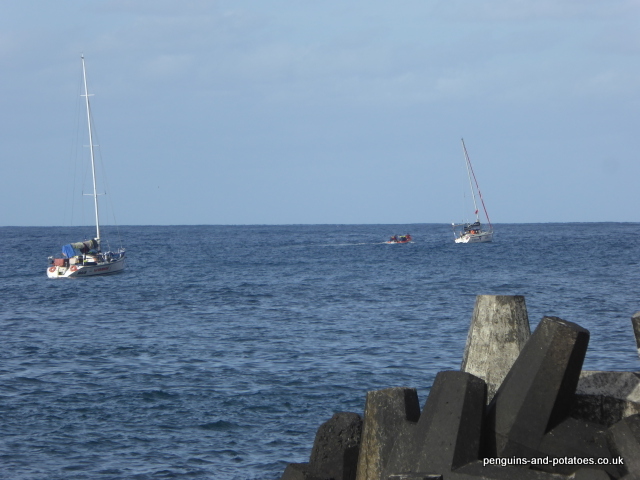
No-one would say that Tristan is a natural destination for cruise ships. The classic pattern of cruise ships is for the passengers to do visits during the day, and for the ship to move on at night to the next wondrous destination. That is not exactly possible here! But there are some speciality, small scale cruise ships that especially visit off-the-beaten-track places, and some of them come here. The risk that they take is that they sell their cruise to include this ‘most remote island in the world’ visit, and there is then disappointment when weather prevents anyone from landing. That happened recently, when on the 24th of March the Silver Explorer was due but the seas were enormous and for safety reasons it was out of the question for the crew to attempt to get anyone ashore. A luckier boat was the French cruise ship Le Lyrial; she had just 160 passengers on board, and they were able to do a stop-off between St Georgia and Cape Town. Of the passengers that we met, they all seemed to be French and Belgian, and they all seemed to really enjoy the charm of the Settlement that is called Edinburgh of the Seven Seas.
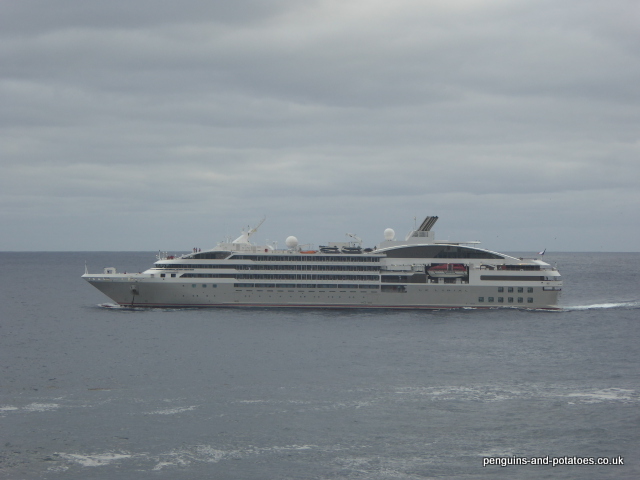
At the other end of the scale, we have had a few intrepid yachtsmen coming here intending to make a visit. In January this year there was a sailing race from Cape Town to Rio de Janeiro; although the race route of course ran substantially north from here, there were a few who decided to bend their route on their return to Cape Town, and to have a visit to this island. I believe that all these visiting yachts were from the Royal Cape Yacht Club, which Bee and I visited with a friend when we were in Cape Town. The first returning yachts were unable to arrange a landing, so they sailed on to Cape Town. These were the Ray of Light and Regardless. Then two yachts came and anchored here at the same time – these were the Rotary Scout and the Scatterling. Then a couple of days later two more yachts came along, but also sailed past and did not stop – these were Marie Galate and Black Cat. Then five weeks later we were treated to a visit from real adventurers; these were the two guys sailing the catamaran Sea Oyster. They also had completed the Cape Town to Rio race, but they had dallied on their return to cruise around some of the Brazilian islands before coming along to Tristan. The sailors, called Jimmy and Stan, had been at school together in Switzerland. They timed their departure from the island quite well – check out the photographs for a view of harbour conditions during their departure, with a similar view taken just 20 hours later. They were so prudent to leave when they did, and to get a good offing away from land before the storm broke that night. There is absolutely no shelter here, no natural harbour. If boats anchor in the lee of the island, there is always the risk of the wind changing and increasing in strength, and of the boat being at risk on a lee shore.
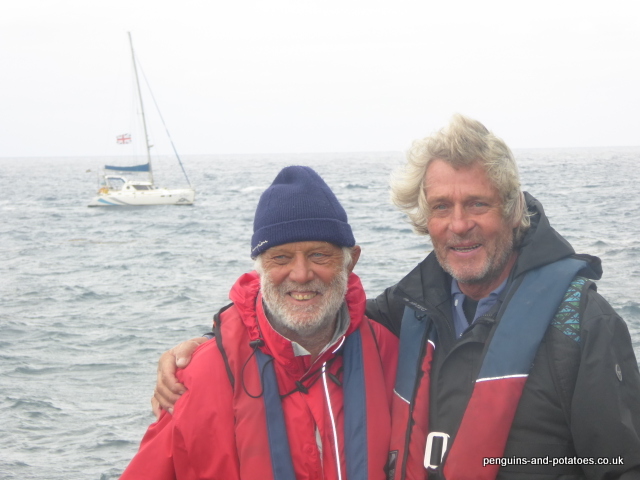
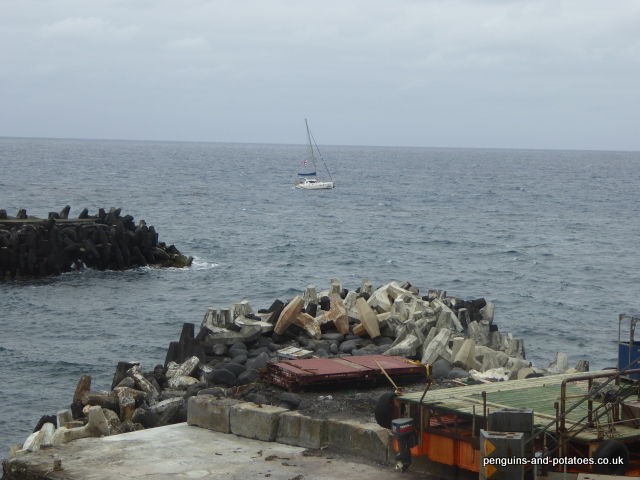
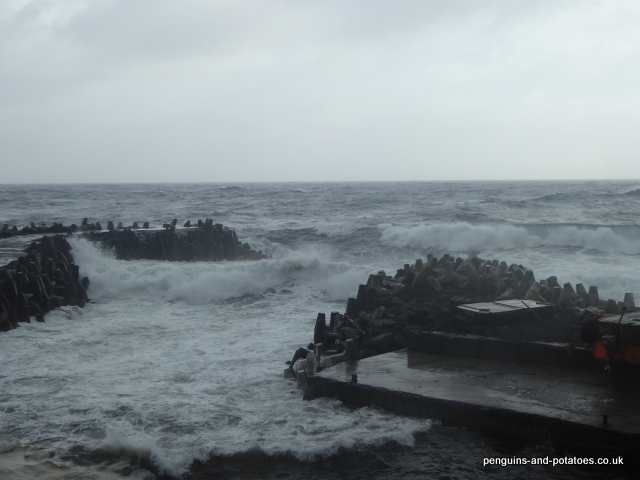
On the 18th of March we were treated to a visit from what must be one of the most beautiful tall ships in the world. The Dutch-registered square rigger, sailing barque Europa, was at anchor here for two nights. With around 18 Dutch and British professional crew and some 40 young trainees, the boat provides adventure and discipline. The crew I spoke to were fascinated by Tristan, and they mentioned particularly the friendliness of the people, the scenery, and the cute houses.
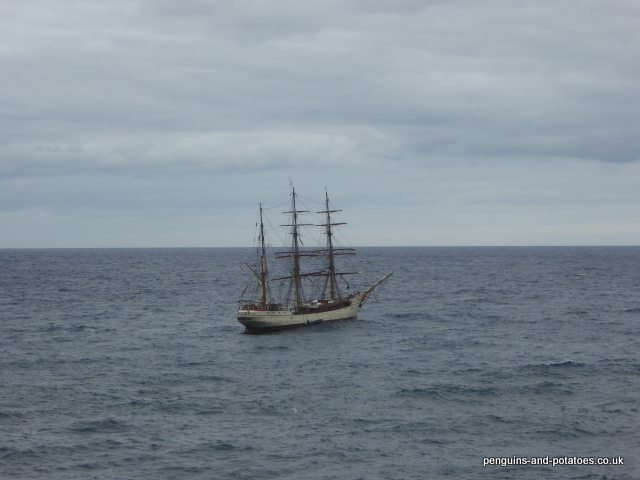
This is a lead into my next blog. I realise that these pages have given very little information on the scenery of the island and on the Settlement itself, so that might be what I will write about next.
Finally, just a quick note to say that our very poor internet system has just got much worse! Indeed, for the last two weeks I have been unable to get into my gmail account. So – if anyone needs to contact me, you can ring if you know the number, or leave a request in the ‘comments’ section here for me to ring you, and the friend who looks after these posts for me will relay your enquiry.
